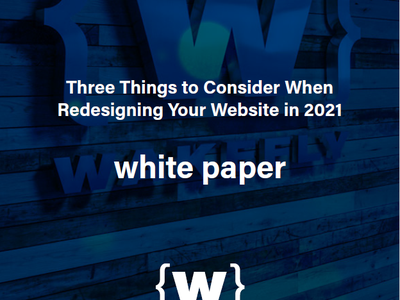Posted on 12/11/2018 in UX and Design
The process of designing and developing a new website can be overwhelming. There are lots of people to coordinate, pressure from above to get it done on time and under budget, and there is often a TON of content to write. With all of these moving parts, it’s not uncommon for marketers to lose focus about who we are really building the site for: the customers.
The measure of success for a website is user engagement and conversions. In order to achieve this, the website must be designed with a focus on the customers. Before you start to design anything, you want to first gather information about your customers and analyze their behavior to uncover what will be most important to them on your new site.
Discovery:
In order to build a site that will resonate with your users, you need to identify who they are. Start by talking to key stakeholders in your business, especially those who regularly interact with customers, like salespeople and customer service. This will help you to develop one or more personas. For a deeper dive into creating personas, check out this post. The most important things to understand are their motivations and goals for using your website.
If you have an existing site, you can also capture live user behavior data by using third party tools like Hotjar or Crazy Egg to see how people are interacting with your site. This might uncover some pain points that you were not aware of. You should also review your Google Analytics to see where users are bouncing off of your site.
Information Architecture/UX:
Now that you have learned what your customers are hoping to accomplish on your website, it’s time to figure out how to make it easy for them. Document user journeys through your site and make sure that your navigation and internal links guide them through naturally. Look for opportunities to minimize the number of clicks it takes for them to perform a task. From a design perspective, keep things simple. Use color sparingly to aid the user in understanding where they are on the site but keep things consistent from page to page. Show related content when possible to keep them engaged.
Content
Customer-focused content is key to a customer-focused website. Even if you are trying to focus on SEO, relevance is more important than ever. Some tips to consider when planning content for your website:
- Make it easy for users to get in touch if they need help and give them options like chat, email or contact form, and phone number. Don't make them hunt for the information.
- Build trust through case studies and testimonials. Help them see themselves using your products and services
- Use clear, compelling headlines and simple, bold CTAs
- Use videos to show rather than tell, especially when trying to explain a complex topic
- If you have segmented your users into more than one persona group, try personalization in a few key areas like banners and CTAs
Iterate and Optimize
After your site is live, it doesn’t mean your work is done. You will want to continue to measure engagement and conversions on your site to see what is working. Even if your initial strategy is a success, it’s important to continue to review because customer behaviors often change over time. The best way to deal with the evolving needs of users is to a/b test. The more testing you do and data you collect, the more you can continue to optimize your site and keep your customers satisfied.
Looking for help on how you can make your website more customer focused?
Reach out to us today to find out how we can help
Related Articles

How Do I Optimize My Website for AI?
Why do you need to optimize your website for AI?AI-powered search engines like Google’s AI Overview, Perplexity, and tools such as Microsoft's [...]

Outdated or Outstanding? How to Tell If Your Website Needs a Refresh
Your website is the digital face of your business. It serves as a first impression, a marketing tool, and a resource for potential customers. [...]

Preparing a Website Redesign Budget for 2025: A Step-by-Step Guide
As we approach 2025, businesses are recognizing the necessity of a fresh, user-friendly website to stay competitive in a rapidly evolving digital [...]
